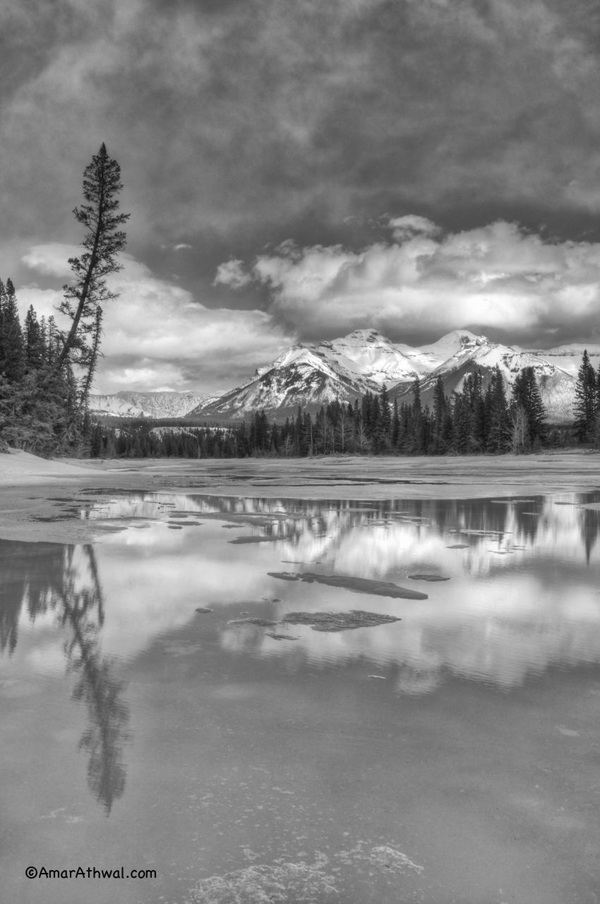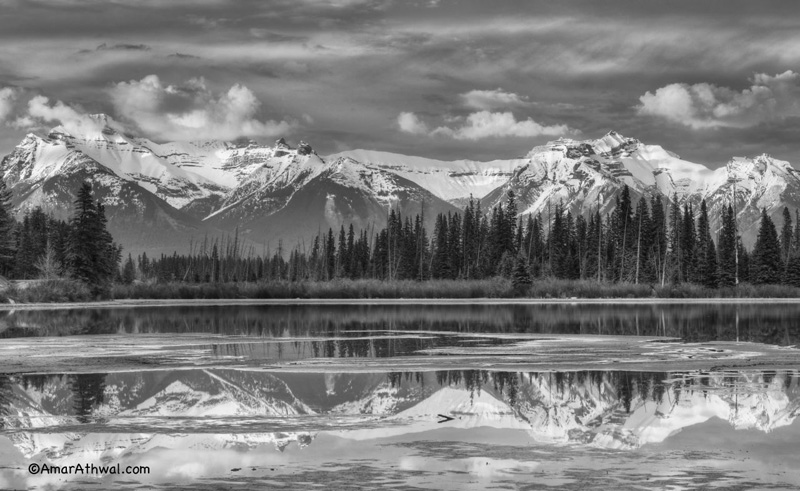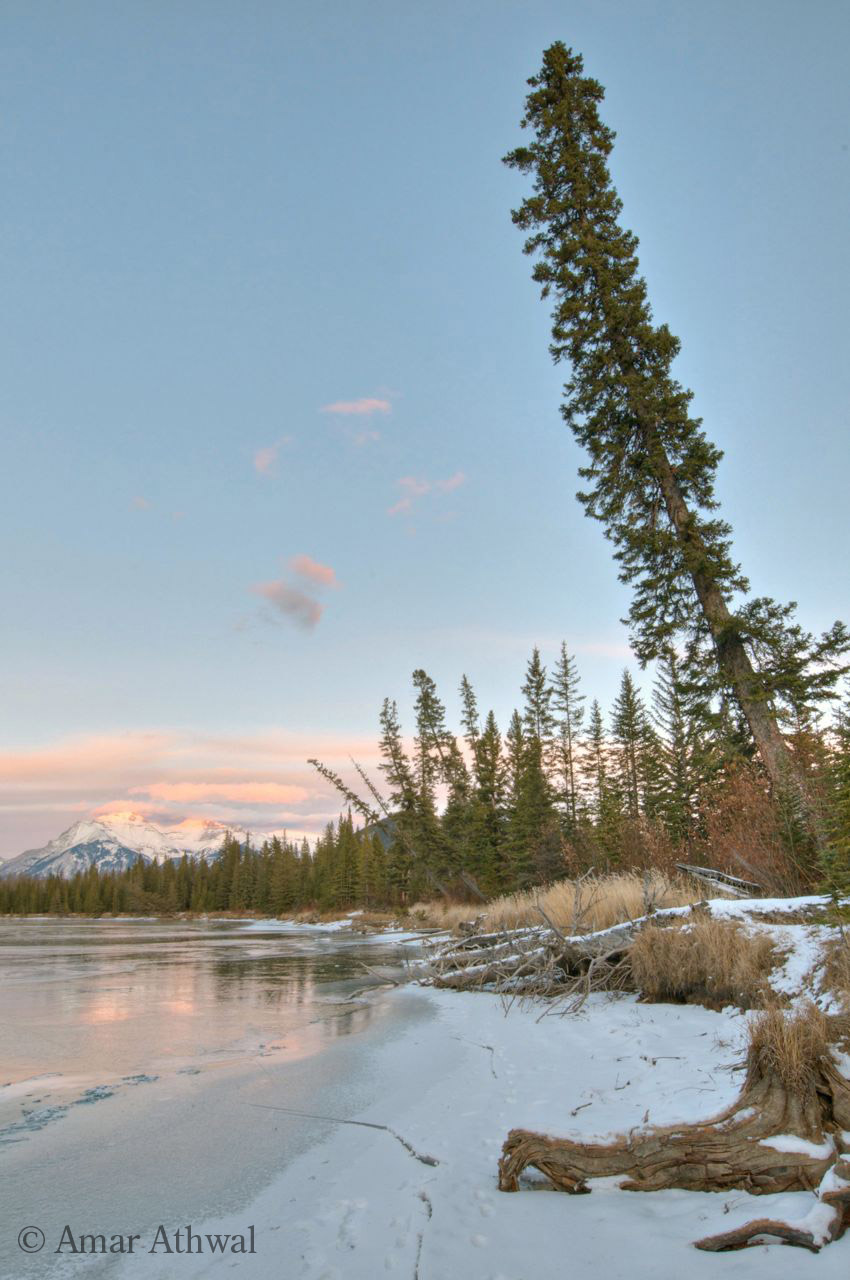Things are changing fast now as spring pushes through. This sunset picture was taken just a couple of weeks ago, as I was looking for a spot with some calm water. Well before the sunset, the sky was already showing some red colour. I just needed to find a spot where the wind would be blocked off by the landscape. The ice was getting weaker, so I also had to make sure I was taking little to no risk where I stood on parts of the frozen river. Just the morning before, about a hundred meters down the river from my location, over seventy elk had crossed the river. Two days after this picture, there was not enough ice for a coyote to cross in the same area. Warmer temperatures, open water absorbing more heat, longer days and the sun getting higher up in the sky each day. All factors helped to open the river for the incoming birds from the south. Even with the three nights of low temperatures we are currently going through, other than needing an extra layer, the day’s temperature is keeping the water open. Providing more places to observe waterfowls after the sunrises.
Fairholme Range
I rarely have people in nature pictures I take. When I do, other than at work or social gatherings, they are there naturally and are not aware they are getting their picture taken. It’s always in a public setting, and they are always looking away from the camera. Just like the pictures I take of nature, I let the events occur naturally and take pictures when the event in front of me becomes interesting. I think this would be my fourth picture I’m sharing as a “moment” with a person. I could have easily removed the person during post-processing. But I decided to leave the person in, like the trees and shrubs, the person gives a sense of scale to the picture. I was about 150 meters from the person who was also taking pictures of the sunrise, and the mountain range is about 14.5 kilometers from us. The lens tends to compress the space. There are many ways to take the picture, each photographer having their style and or personal preferences. As for having myself in the pictures I take. What can I say, I take a look at myself in the mirror in the morning, and I’m good for the day.
Fairholme Range
Visualizing what picture you want is an important part of photography. This step can also save you lots of time. By pre-visualizing, not only are you thinking about will the conditions in front of you will make for a good image. But also thinking can the camera pick up what our eyes are able to see. Our eyes still have a greater dynamic range than the best camera on the market, even more compared to our phone’s camera. The dynamic range is the ratio between the brightest and darkest parts.
During some sunrises and sunsets, the camera does not even come out of the pack if certain conditions are not met for a good image. During a full moon night, when your eyes can not only pick out the details in the moon, but also in the surroundings around you. With the camera, you will have to take multiple shots, exposing separately for the details in the moon and the ground. Then using an application on the computer to put different parts of each image together to create what your eyes were seeing. Even then, it will end up being different from what our eyes saw.
During the night or early in the morning or late in the day, there are flashes and portable lights you can use to get a half decent picture of wildlife. But that’s a terrible thing to do. Us humans are thrown off when a flash is used on us during the dark. Let along what the wildlife feels that have far more sensitive eyes than us. Last week, when I saw three red foxes at three separate locations as I was coming home in the dark, unless they were in my vehicle’s headlights, no picture was going to be taken. Later was the case. The camera stayed put.
For this image. I was coming back home when I saw the moon, clouds and the mountain range in the late evening light. I knew before even getting off the highway and getting on the Vermilion Lakes Road. I had an image in front of me waiting to be taken, where I needed to go and take it from and it was going to end up as a black and white image. Other than the trees in the foreground, which I wanted to be dark anyway, the peaks, clouds and the moon were under the same light. The camera was going to give me the image I was seeing. Making it black and white was my creative choice. Visualization and getting good images. The more you practice, the easier it gets.
Moon over Fairholme Range
Nature photography is always a game of wait, for this image I was waiting for the moon to be in the open before the last light left the mountains. The clouds behind me were moving in and soon after I grabbed this image the light was off the peaks for the day.
Fairholme Range
Having patience is a big part of nature photography, but staying composed while dealing with the elements also plays a big role. That was the case when I got this sunrise picture. It was a cold morning with heavy winds blowing snow over the frozen lake. I was taking small steps on the open ice so as not to slip and I tried not to face the wind to keep warm. After being out there for half an hour and after the bright part of the sunrise, the light was getting softer but I still wanted to take one more picture. The hands were cold and the toes were making their way in that direction as I searched for a different foreground. I noticed the tracks in the snow, they belonged to the wolf pack, they were about a week old. The light was fading, so quickly I set up the equipment and then composed the shot. Another sunrise was enjoyed, followed by a walk to the warmth of the car.
Fairholme Range
As beautiful as the morning was, I did not have any time to enjoy watching the sunrise, just wanted to take the pictures and run. I was in the middle of swarm of mosquitoes, it has been their summer to flourish. Before I would take any picture, I would first wave my had front of the lens and then take the picture. After the last picture taken, I packed up, looked up at the hundreds of mosquitoes and then made a quick exit.
Fairholme Range
If you have seen on a clear sky a reddish glow in the opposite direction to the sun rising or setting, just above the horizon. Before the sun comes above the horizon in the morning or after the sun has gone below the horizon end of the day. You were looking at an alpenglow, not to be confused with the alpenglow my face gets when I have eaten chocolates in the mountains. No clouds are needed for the reddish glow, but you do need precipitation, ice crystals or particulates in the lower part of the atmosphere. The light gets reflected off them and you get a beautiful reddish glow above the horizon. After sunset, you can get this even without the mountains, but the snow covered mountains do add to the beauty.
Fairholme Range
Toward the end of the day, with the lenticular clouds still in the sky, picture of part of the Fairlholme Range.
Fairholme Range
Last week I was back at the Vermilion Lakes taking pictures of Mount Rundle and Fairholme Range toward the end of the day. The water was slowly rising and some shaded areas still had some snow and or ice. But spring is here and everyday there is less snow and ice.
Fairholme Range
At the end of the day, light peaked through the clouds and lit up top of the mountains and a cloud just above them and all was reflected in the calm water.
Until next moment,
Amar
Fairholme Range

It was a mild day as I walked on melting ice of the Bow River. With each step I was leaving a clear deep boot print in the ice, always making sure to stay on the side of the river, where there was no running water underneath the ice. Carefully looking to the sides and to the front of me to see where I needed to stop to take the pictures. I often go by feel, what looks good to me, what is worth stopping for to take a picture or pictures. Once my mind has decided its worth stoping, then its time to look through my camera to decide what to include and not include to make the most of the opportunity. Deciding how much fore ground to include, how much sky to include, should I include the tree or trees to the left, should I get low to the ice or stand tall, etc, etc, etc. If time is on my side I'll take several pictures by varying the variables, deciding at home which combination of variables gives me the best image of a particular shoot. In this case it was the variables of the last picture I took that day.
Until next moment,
Amar
Fairholme Range

Spent a long day waiting for my car as it got serviced. Was happy to get back home and have a quick bite before getting outside to see if I could get few pictures of the sunset light hitting the mountains. The water was calm and the light was just right as I went about creating a panorama. To create a large file I decided to use my zoom lens to zoom in on the Fairholme Range. The attached picture is made up of four images, giving me the option of printing a large poster with all details I saw while taking the pictures.
Until next moment,
Amar
Two Jack Lake

Well, we woke to our first major snowfall in the Bow Valley this morning,and its only mid September. Many of the leave holding trees and shrubs felt the wait of the wet snow, fallen branches of all sizes can be seen around the valley and in some case the whole trees. In the evening I headed for Two Jack Lake to take pictures of the Failholme Range reflecting on the lake. I was happy to find shrubs by the lake, still holding their leaves. Produceing a nice contrast with the snow, as well as grounding the picture.
Until next moment,
Amar
Fairholme Range

One of the great gift evolution has given us is the ability to walk, taking one step at a time. For me its the perfect pace for my eyes to find the pictures I want to take while my feet follow the trail. Often drifting toward a know destination or exploring finding new spots to take pictures form. In some cases keeping these spots back of my head for future returns. I have never had a bad walk or hike in the mountains, no matter the weather. Weather is only there to tell us what to wear.
I would not mind if on each visit, my feet were on a trail I had not stepped on before, as there are many among the mountains. But having limited time for hikes, trails close to the home get multiply uses. I was on one of these trails, walking along the river, every now and then stopping to listen to the birds that will be spending their winter in the mountains. The daylight was coming to an end, but before it left it was producing a warm glow top of Fairholme Range and the clouds above it. I stepped off the trail and got along side the frozen river to find a location for the picture I wanted to take. Soon after the light left for other ranges.
Until next moment,
Amar









